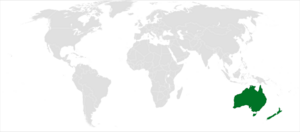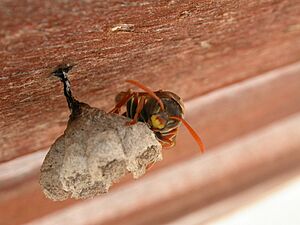Australian paper wasp facts for kids
Quick facts for kids Australian paper wasp |
|
|---|---|
 |
|
| Conservation status | |
| Scientific classification | |
| Subspecies | |
|
|
 |
|
| Distribution of Polistis humilis |
The Polistes humilis is a type of wasp often called the common paper wasp. You can find it all over Australia. It was also accidentally brought to northern New Zealand. These wasps have long, thin legs and yellow and black stripes. They are known for using their old nests again.
Even though all females look alike, queens and worker wasps act very differently. These wasps are also eusocial, which means they live in organized groups and help each other. Polistes humilis wasps can give a painful sting, especially if their nest is bothered. This sting helps them protect their home. While some people don't like wasps, they are very important for helping many plants grow by pollinating them.
Contents
What is a Polistes humilis?
How do we classify these wasps?
Polistes humilis belongs to a group of wasps called Polistes. There are about 150 different Polistes species found almost everywhere in the world, except in the coldest places. In Australia, there are 11 different Polistes species, and Polistes humilis is the most common one.
This wasp was the only type of Polistes found in New Zealand for a long time after it arrived from Australia. Later, another Asian paper wasp, Polistes chinensis, arrived in 1979. Scientists used to think Polistes variabilis was a subspecies of Polistes humilis. But new studies show they are actually two separate species. Polistes humilis has two main types: P. humilis humilis in northern Australia and P. humilis synoeus in the south.
What do they look like?
You can spot Polistes humilis by its slim body and striped pattern. Adult wasps are about 10-15mm long and have a yellowish-red color. Their faces are yellow. Male wasps have a yellow mark on their abdomen that females don't have. These wasps are usually bigger than most other paper wasps.
Their nests are shaped like cones and have many hexagon-shaped cells. The wasps build their nests using a mix of wood fibers and their own saliva, which makes the nest look grey. Unlike many other wasps, Polistes humilis colonies often use the same nest for several years. Some colonies even stay in the nest during colder months, sheltering above the comb.
Where do they live?
Polistes humilis wasps are mostly found in Australia. They are common in southern Queensland, New South Wales, Victoria, and South Australia. They were accidentally brought to New Zealand in the 1880s. Now, they have a steady population there, mostly on the North Island.
These wasps are most common in shrubland areas. But you can also find them in flax swamps and forest areas.
How do their colonies work?
The colony's yearly cycle
The life cycle of a Polistes humilis colony begins in the spring. It can start in a few ways.
- First, a new nest can be built, usually by several female wasps called foundresses.
- Second, the wasps might reuse an old nest, even one that's several years old.
- Third, if the colony stayed active through winter, they just keep using their old nest. When old nests are used, new eggs are usually laid near the old cells.
Throughout the year, the nests follow a clear pattern. In spring, females who survived winter and have mated start new nests. Worker females are born in late spring and early summer. Male wasps and new queen females are born in late summer and early fall.
Wasp behavior
Who's in charge?
In Polistes humilis nests, there's a clear boss: the queen, who lays eggs. The other females are sterile workers. All females look the same, even small ones can lay eggs. Since they don't look different, their behavior shows who is the queen. Queens often get food, honey, and water from workers who return from finding food.
A "tail wagging" movement of the lower body part often shows who is dominant. But unlike many other species, Polistes humilis females don't fight much for who gets to lay eggs. This is probably because the wasps in a nest are very closely related.
How they mate
Polistes humilis queens usually mate with only one male. This means all the eggs from one queen are fertilized by that single male. However, a single nest can have an average of two queens. Having multiple queens likely helps protect the nest. Since different males can fertilize different queens in the nest, the nest has more varied genes. This can help protect the colony from diseases. Also, these wasps do not mate with family members from their own colony. This suggests that male wasps leave their home colony before they mate.
Living together: The good and bad
Benefits of a big nest
There are clear advantages to having larger Polistes humilis nests. As a nest gets bigger, more queens can lay eggs. This means the wasps in the nest are less closely related to each other. This might help protect against diseases, as more varied genes can stop sickness from spreading.
Also, bigger nests mean more wasps. More wasps mean better defense against animals that might try to attack the nest, or even against people.
Dealing with conflict
Since queen wasps don't look much different from worker wasps, they use behavior to stop workers from laying eggs. Queens want to have as many of their own babies as possible. So, it's likely that queens eat the eggs laid by weaker females. This limits how many eggs other females can produce.
Dominant females also show their power by vibrating their gaster (the back part of their body) and by climbing on or wrestling with other females. These actions help the queens make sure their offspring survive and keep the wasps in the nest closely related.
Interactions with other species
What they eat
Polistes humilis wasps eat food that worker wasps bring back to the nest. Workers share this food with the queen and the young larvae. They eat water, wood pulp, and prey that provides carbohydrates and protein. In southern Australia, Polistes humilis often eats caterpillars (larvae of butterflies and moths) for protein, as well as small spiders.
Polistes humilis has to compete for food with other species, especially the Vespula germanica wasp, which is an invasive species. While Polistes humilis is very common now, competition for food could reduce its numbers in the future.
How they defend themselves
Polistes humilis has a very strong defense: its sting. The venom in their sting helps them catch prey and protect their nest from predators. The venom comes from two glands and is squeezed out by strong muscles. The venom is used in fights between species and usually in small amounts. The venom contains chemicals like serotonin and histamine, which are known to cause pain.
Fighting off sickness
Polistes humilis has two ways to fight off diseases: having different genes and making special chemicals on their bodies that kill germs. There's a balance between these two defenses. Bigger colonies tend to have more genetic variety. Smaller colonies tend to make more of the germ-killing chemicals. This is likely because making these chemicals uses a lot of energy, so larger colonies might not be able to produce as much.
These defenses work together. For example, studies show that more genetic variety in a certain gene helps make the germ-killing chemicals stronger. These defenses are very important for the colony to survive. Since the germ-killing chemicals are found in the wasp's venom, and only female wasps can sting, larger colonies with more males might not be as good at this defense. The size of the group and how well they fight germs are key to how easily they get sick.
Why are they important to humans?
Nests and stings
Polistes humilis is probably best known to people for its painful sting. These stings often happen when someone accidentally disturbs a nest. Polistes humilis nests are often found in places where human buildings and plants mix, like in walls, under the eaves of buildings, and on fences. Because of this, humans are at a higher risk of accidentally bothering a nest.
While the sting hurts a lot, it's usually not dangerous unless someone is allergic. The best way to avoid a sting is to simply stay away from known nest sites. These wasps usually only sting when they feel their nest is in danger.
Their role in farming
Polistes humilis wasps are important for the environment because they help pollinate plants. Since this species is one of the most common in Australia, it helps many native plants survive. Polistes humilis pollinates a wide variety of plants.
While this is good for native plants, it also affects non-native species. When new plants are brought into an area, their success often depends on finding pollinators. Since Polistes humilis pollinates many different plants, they have been seen helping invasive plants, like the milkweeds Asclepias curassavica and Gomphocarpus fruticosus, to spread.
Images for kids






